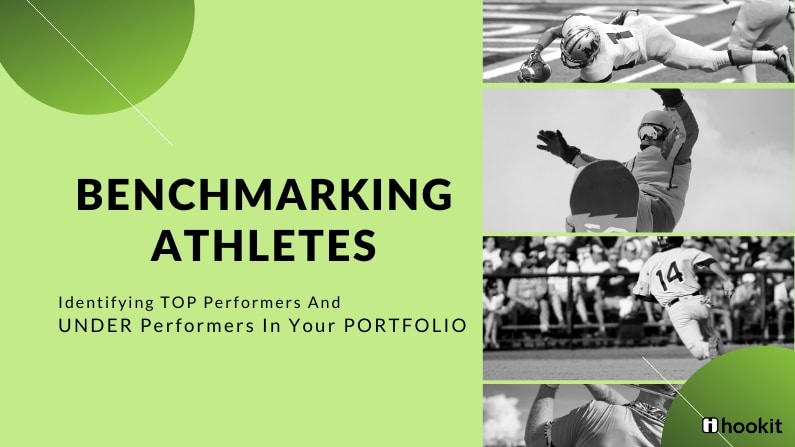Brands spend a considerable amount of time and effort in identifying the perfect ambassadors who will help drive the goals of the brand, both on and off the field. Not all ambassadors are the same – there are variations among them, such as the audiences they identify with, their personal style, how engaging they are on social media, and more. However different they are individually, it is essential that they meet their brand goals, to be considered effective ambassadors of that brand.
Brands can identify how well their sponsored ambassadors are performing, who their top and under performers are, and more, through benchmarking. Hookit’s benchmarking tools enable brands to measure the performance of their ambassadors by identifying the value they drive for the brand and the effectiveness of their social media promotions. The metrics and methodology that Hookit uses to achieve all this is detailed below. To illustrate, a leading brand with ambassadors across various sports has been chosen as an example.
Benchmarking – Valuation
The most essential metric that a brand can use to gauge an ambassador’s performance on social media is the value the ambassador drives for the brand. This is a good measure of how much value the brand is set to earn from the brand ambassador’s posts on social media.
Brand example:
First, it is helpful for a brand to identify which group of its sponsored entities drive the most value through branded posts. For example, the brand shown received a major portion (77%) of the value generated through its athlete ambassadors rather than sponsored teams.

Now that the brand has identified that athletes are its major value drivers, the brand can learn more about who the top performers are and how much value they have driven for the brand within a specific time period. Rankings provide a quick snapshot of both top performers as well as under performers of the brand. Sport marketers can further learn more about the performance of each athlete through the athlete’s scorecards.

Some insights the brand can gain from these rankings are:
- The top athlete drives a Maximum Ad Value (MAV) that is more than 17 times higher than the MAV of the athlete in 10th place. The brand can use the top athlete as the benchmark and learn more about which posts of the top athlete have driven the most value, why those post were successful for the brand, and more.
- The brand can then use these insights to educate its other ambassadors and sponsored entities on which techniques are more successful at driving value for the brand.
- The best practices gleaned through the top athlete’s posts should also be used to improve the performance of its under performers.
- The majority of the top performers for the brand are well known star athletes in their respective sports, and yet the value driven by these athletes are significantly less than the brand’s top athlete. Further research into these ambassadors’ posts and their share of voice for the brand can help identify the reason for the lower MAV generated by these ambassadors. (More on those below).
Setting a benchmark based on the top performer is advantageous to the brand, as it helps set reasonable and achievable goals for brand ambassadors, provides the brand with a measure of how well each ambassador is performing, and how much improvement is needed in relation to the top performer.
A note on MAV: To accurately gauge the value a sponsor earns from its branded posts, Hookit employs its proprietary Hookit Valuation Model (HVM). The HVM starts with the MAV, which is the total value the brand could earn from that particular social post if it were a perfect advertisement for the brand. This MAV is then scored against the post’s quality of promotion to arrive at the Adjusted Ad Value (AAV). Ensuring that branded posts have good promotion quality will maximize brand value earned. Get the full details of the Hookit Valuation Model and promotion quality here.
Benchmarking – Promotional Effectiveness
Often, brands need to be able to compare how effective their ambassadors are at promoting the brand irrespective of their social media followers. Since brands can lose sponsorship value if the ambassador’s promotion is poor, Hookit has developed the Promotional Effectiveness Score to help brands learn how effective their ambassadors are at promoting the brand.
Brand Example:
Some brands can afford star athletes that have a huge number of fans who translate into a large social media following for the athlete. However, there are lesser known athletes or athletes who are rising stars, who are yet to reach the level of social media followers that star athletes have. These athletes may be better ambassadors for the brand if they have highly engaged fans, even if they don’t have as many followers. The PE score helps identify these athletes, as the score only looks at how well the athlete promotes a brand and not the athlete’s social media followers.
An ideal brand ambassador would be one who has a high PE score and drives a high MAV for the brand. In the time period considered, these are the top 5 athletes for the example brand based on PE Score.

Among these top 5 ambassadors, golfer Jordan Spieth is the only athlete with more than 4M social media followers, while all other top 5 ambassadors have less than 300k social media followers. However, these are the ambassadors who are the best at promoting the brand and should therefore be the benchmark based on which the brand should evaluate the effectiveness of its other ambassadors.
To compare, when considering the PE Score of the top 5 brand ambassadors who generate the highest potential brand value (MAV), it can be seen that these ambassadors have lower PE scores. This implies that although they drive high MAV for the brand, they could be more effective brand promoters.

Benchmarking the top value drivers with top ambassadors by PE score helps the brand understand that the gaps present in the branded posts of its top value drivers. By implementing best practices of effective promoters, the brand can further increase the promotion quality of other ambassador’s branded posts and ultimately the AAV earned from its ambassadors.
Benchmarking – Volume and Share of Voice
Brands can also learn which of their brand ambassadors are passionately talking about the brand and expanding the brand megaphone through metrics like ‘Volume of branded posts’ and ‘Share of Voice’. Volume of branded posts shows brands the total number of social media posts by its ambassadors that featured their brand hashtag, mention, text or logo, within the time period considered. Share of Voice lets the brand know among all the branded posts of the ambassador, how many featured the sponsor brand compared to other brands that also sponsor that individual.
Volume of branded posts
An overview of the brand’s ambassadors shows that the total number of branded posts by its ambassadors (i.e., total number of posts that featured all the sponsor brands of the brand’s ambassadors) in the time period considered was 9.8k. Of this, only 885 or 9% of ambassadors’ posts featured the brand considered. The implication is that the volume of branded posts for this particular brand was low and its ambassadors were promoting their other sponsor brands more.

Knowing this, a brand can dive into these posts and identify what other brands are being talked about by their ambassadors. The example below shows the number of posts by one Under Armour ambassador about any brand. In this case, Under Armour is getting mentioned more than any other individual brand, but the other brands get more mentions in total than Under Armour does.

The above snapshot helps brands learn which other brands share space with their posts, the proportion of these posts in relation to theirs and more. This can also be a good way for brands to find potential marketing partners to cross promote each other through their shared ambassadors.
Share of Voice
For the brand considered as an example, it can be seen that among all its ambassadors, only 74% of brand ambassadors have promoted the brand on social media. Nearly 1/4th of its ambassadors have not posted about the brand during this time period.

The brand can drill down further to find out which of its ambassadors were the ones who promoted the brand the most and which ambassadors had less/no branded posts.

From the above table it can be seen that 8 of the top 10 athletes by share of voice have promoted the brand in every branded post, while the majority of the branded posts by the other 2 ambassadors feature the brand.
On the other hand, the brand can also identify the ambassadors who promoted other sponsor brands but had less to no branded posts about this brand.

It can be seen that one of the top value drivers of the brand, Anthony Joshua posted less than 10% of their branded posts about the example brand while promoting their other sponsors more extensively. Education about the importance of increased share of voice in branded posts and setting certain benchmarks for these ambassadors to achieve them will help drive more value for the brand.
Volume and share of voice help brands identify ambassadors who have passionately advocated for the brand on their social channels as well as ambassadors who are poor at promoting the brand. Using this data, a brand can set certain benchmarks for sponsored entities, such as number of branded posts that need to be posted on social media within a time period, to ensure that the brand name is kept relevant among the ambassador’s audience and value is generated from these posts.
Benchmarking – a necessity
Brands need to set certain benchmarks to ensure that brand ambassadors are enabling the brand’s goals. Brands invest heavily in their brand ambassadors and setting benchmarks helps brands measure the performance of its ambassadors in a meaningful and practical way. That way, during and at the end of a contract, both sides can have clear expectations on whether the partnership was successful and whether it should be renewed.



